Thank you, Madam Chair.
I'm with the senior personnel secretariat in the Privy Council Office. We provide advice and support to the Clerk of the Privy Council, the Prime Minister, and cabinet in all matters pertaining to Governor in Council appointments.
I'm pleased to be here today with my colleague, Paul Shuttle, who is the assistant director of legal operations for the Privy Council Office.
Based on the committee's motion of January 29, 2008, I understand that members are principally interested in hearing testimony on issues relating to Governor in Council appointments to independent arm's-length agencies, and also about the public appointments commission.
I have a very brief opening statement on these issues. Afterwards, we would be happy to answer your questions. I hope you will understand that we are not in a position to delve into the specifics of the Linda Keen matter because it's now before the courts. Nevertheless, I hope we can provide useful information more generally on these questions.
Governor in Council appointments are either for a fixed term or an indeterminate period and their tenure is either “during good behaviour” or “during pleasure”. Appointees who hold office during good behaviour may be removed by the Governor in Council for cause. Appointees who hold office during pleasure may be replaced or removed at the discretion of the Governor in Council.
Pursuant to the Interpretation Act, appointments are deemed to be during pleasure, unless otherwise expressed in the enactment, commission or instrument of appointment.
The selection process for these positions is the same, irrespective of their tenure, as the government's aim is constant: to attract highly-qualified persons to head its various agencies, boards, commissions and crown corporations.
These positions are advertised, as a minimum, in the Canada Gazette and on the Governor in Council appointments website. In some cases, executive search firms are also hired as part of the recruitment strategy. Selection committees interview candidates in order to identify the most qualified persons for the government's consideration in making these appointments.
The process which cabinet follows before it decides whether or not to remove an appointee from office is determined by the rules of procedural fairness and, where applicable, in legislation.
In the case of “at pleasure” appointees, it is not necessary for the government to show cause but it is required to notify the appointee of the possibility of removal from office and provide that person with the opportunity to be heard.
The procedural requirements to remove a “good behaviour” appointee are similar. However, in those instances, cabinet would have to have cause before it could terminate the appointment.
The Federal Accountability Act provides that the government may establish the public appointments commission to oversee and report on the selection processes for appointments by the Governor in Council to agencies, boards, commissions, and crown corporations. I would point out that the commission's mandate does not, under the legislation, extend to removal from office.
As you know, the commission was established administratively by order in council on April 21, 2006. Prior to the passage and coming into force of the Federal Accountability Act, the government appointed three members for the commission and nominated Gwyn Morgan to be chairperson. As you know, on May 16, 2006, this committee did not support Mr. Morgan's nomination, following which the three members of the commission tendered their resignations.
Nevertheless, in keeping with its commitment to appoint qualified persons to public office, the government has conducted more than 100 open selection processes to fill key positions since taking office. Moreover, selection processes are run to find qualified candidates for positions such as citizenship judges and for agencies such as the Veterans Review and Appeal Board and the National Parole Board, to name two examples.
At this point, Madam Chair, I'd be happy to answer any questions you may have.






